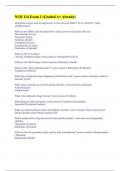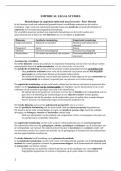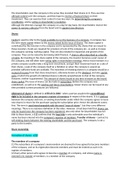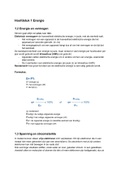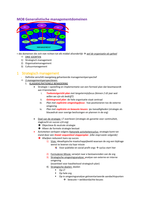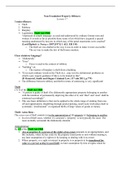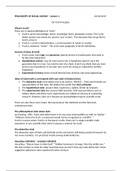Business: an organisation that uses resources to meet the needs of customers by providing a product/service in demand
Consumer goods: physical and tangible goods sold to public -> durable/non-durable: washing machine/food
Consumer services: intangible products sold to public (hotel stays/insurance services)
Factors of production:
➔ Land: renewable & non-renewable resources of nature (coal/oil/timber)
➔ Labour: manual & skilled labour (workforce for bus)
➔ Capital: man-made resources used in production
- finance needed for set-up/continuing
Capital goods: physical goods used by industry to aid in the production of other goods/services (machines/computers)
Creating value: increasing the diff between the cost of purchasing bought-in materials and the price the finished good goods are sold for
Added value: the diff between the cost of purchasing bought-in materials and the price the finished good goods are sold for
Opportunity cost: the potential benefits an individual/investor/business misses out on when choosing one alternative over another
Dynamic business environment: the business environment which is constantly changing -> businesses have to adapt quickly to changes
and develop new ideas, products and services to keep up with technology and new trends.
Changes in the environment include:
● New competitors entering market
● Legal changes- safety regulations/limits
● Economic changes- inflation/deflation
● Technological changes- outdated trends
Entrepreneur: someone who is willing to take the financial risk of starting/managing a new venture
Intrapreneur: an entrepreneur within an existing business
Business plan: a document that defines in detail a bus’ objectives and how it plans to achieve its goals to obtain finance for the start-up.
>> includes; executive summary, description of the bus opportunity, marketing and sales strategy, management team and personnel,
operations, financial forecasts.
Triple bottom line: aims of social enterprise which includes economic, social and environmental
Economic - to make a profit to reinvest back to the business and provide some financial returns to the owners
Social - to provide jobs or support for local, often disadvantaged, communities
Environmental - to protect the environment and to manage the business in an environmentally sustainable way to benefit in long term
Social enterprise: a business with mainly social objectives that reinvests most of its profits into benefiting society rather than
maximising returns to owners
Economic sectors:
➔ primary sector: firms engaged in farming, fishing, oil extraction and all other industries that extract natural resources so that
they can be used and processed by other firms.
➔ secondary sector: firms that manufacture and process products from natural resources.
➔ tertiary sector: firms that provide services to consumers and other businesses, such as retailing, transport, banking.
Command economy: economic resources are owned, planned, and controlled by the state.
Public sector: comprises organisations accountable to and controlled by the state.
Public corporation: a business enterprise owned and controlled by state
Private sector: comprises businesses owned and controlled by individuals or groups.
Mixed economy: economic resources are owned and controlled by both private/public sectors
Free-market economy: economic resources are owned largely by the private sector with little state intervention.
Sole trader: a business owned and run by one person responsible for decisions and taking all the profit
Partnership: a business owned and jointly by two or more people who share the profit and responsibilities
Incorporation: occurs when a business is set up as a limited company - a separate legal entity and its owners have limited liability
Limited liability: the potential loss shareholders have if the company fails is the amount invested in the company not their total wealth.
Private limited company: a business that is owned by shareholders who are often members of the same family
, Public limited company: a business that is own by shareholders which the shares are issued publicly to anyone via stock exchange
Shareholder: a person or institution owning shares in a limited company (dividends/rights)
Franchise: a business that uses the name, logo and marketing methods of an existing business through contract
Cooperative: a business that is owned and run by its members, sharing the workload, decision-making, usually in agricultural and retailing
Joint ventures: when two or more businesses work together on a particular project, such as building a bridge, and this last only for the
duration of the project
Holding company: a business organisation that owns and controls a number of separate businesses, but does not unite them into one
Strategic alliances: a form of external growth that does not involve complete integration or changes in ownership. Instead it keeps the
parties to the agreement independently. Once the objective is achieved, the alliance is ended.
Chain of command: the route through which orders are passed down from senior managers to employees on the lower levels of the hirer
Span of control: the number of people directly report to one person
Capital employed: total value of long-term finance invested
Market capitalisation: total value of company’s issued shares
Revenue: total value of sales made by a business in a given time period
Market share: sales of the business as a proportion of total market sales
Internal growth: expansion of a business by means of opening new branches, shops, or factories
Mission statement: a statement of the business core aims -> motivate employees/stimulate interest
Corporate Social Responsibility (CSR): the concept applies to those businesses that consider the interests of society by taking
responsibility for the impact of their decisions and activities on customers, employed, communities and environment beyond the legal
obligations that they have.
Stakeholders: people or groups of people who can be affected by any action by an organisation
Corporate objectives: goals and targets that can be broken down into strategic departmental targets, which are based upon the central
aim or mission of the business => profit maximisation, profit satisficing, growth, increasing market share, survival, CSR
Profit maximisation: producing at a level of output where the greatest positive difference between total revenue and total costs is achieved
Profit satisficing: aiming to achieve enough profit to keep the owners happy but not aiming to work to earn as much profit as possible


